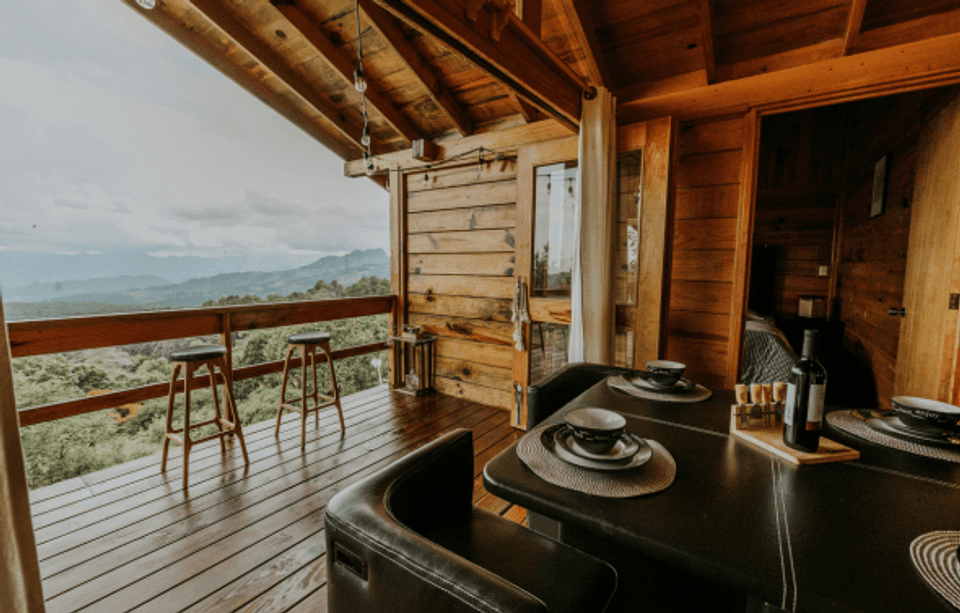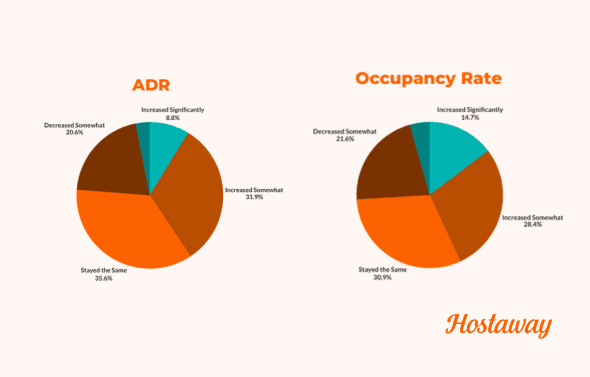Summer 2025 Report: How 40% of Short-Term Rental Operators Boosted Occupancy and Rates

Key Takeaways:
40% of short-term rental hosts increased both occupancy and ADR in Summer 2025 by embracing smarter technology, better pricing and guest-focused operations.
Dynamic pricing tools drove stronger revenue performance, helping 62% of hosts stay competitive during peak and low-demand periods.
Direct bookings grew for 37.5% of hosts, reducing OTA reliance and building stronger, repeat guest relationships.
Proactive maintenance and communication paid off, with 35% of hosts improving guest ratings and boosting repeat stays.
AI adoption surged from 60% to 84%, making Hostaway’s all-in-one PMS and automation tools essential for connecting pricing, communication and operations at scale.
Why Did 40% of Vacation Rental Hosts See Higher Occupancy and Rates This Summer?
According to Hostaway’s 2025 Summer Snapshot Report, 40% of short-term rental operators reported higher occupancy rates and stronger average daily rates (ADR) compared to summer 2024. In a year marked by inflation, rising travel costs and mounting competition, that kind of growth stands out.
Across the industry, some short-term rental operators didn’t just survive, they thrived. While others struggled with fluctuating demand or stricter margins, these hosts found ways to attract more guests, earn better reviews and raise their nightly rates without losing bookings.
So what did they do differently?
This article breaks down the top strategies that separated the winners from the rest. Using fresh short-term rental data from the Summer Snapshot Report 2025, we’ll unpack how top-performing hosts leveraged technology, fine-tuned pricing, improved guest communication and embraced AI-driven operations to stay ahead in a competitive vacation rental market.
Whether you manage a single Airbnb or oversee dozens of short-term rentals, these insights reveal what’s driving real performance gains and how you can replicate them.
type: embedded-entry-inline id: 7LT0vp4Z3DW36OfJj7v5AW
What Tools Help Short-Term Rental Hosts Improve Performance?
If there’s one theme running through the Hostaway Summer Snapshot Report 2025, it’s this: the hosts seeing the best results are the ones using the right tools. Technology isn’t a “nice-to-have” anymore, it’s the foundation of profitable short-term rental performance.
The report found that property management systems (PMS) and channel managers continue to form the backbone of most operators’ tech stacks. From automating guest messages to syncing calendars and updating rates across platforms, these tools are what make it possible to manage multiple listings efficiently.
Beyond that, adoption of dynamic pricing software (62%), home automation tools (46%) and accounting software (42%) shows that hosts are investing in smarter systems that save time and improve accuracy. Even website builders (29%) are gaining traction as more hosts shift toward direct bookings.
Here’s how tech adoption has evolved over the past year:
Tool/technology | 2025 adoption | 2024 adoption | Why it matters |
PMS / Channel Manager | ~90% | ~88% | The operational core. It connects listings, automates communications, prevents double bookings, etc. |
Dynamic Pricing Tools | 62% | 55% | Helps optimize nightly rates to boost both occupancy and ADR. |
Home Automation | 46% | 38% | Reduces check-in issues, energy waste and maintenance calls. |
Accounting Software | 42% | 35% | Keeps finances clean and tax-ready for scaling operations. |
Website Builders | 29% | 22% | Drives more direct bookings and brand visibility. |
The takeaway? Operators who built a connected tech ecosystem were better equipped to handle the fast pace of today’s vacation rental market. A PMS provides structure, dynamic pricing ensures competitiveness and automation smooths out guest communication, all essential ingredients for growth in 2025.
Better communication doesn’t just boost ratings, it feeds directly into higher visibility on booking platforms and more return stays. For hosts aiming to improve guest reviews, build trust and keep calendars full, consistent messaging is one of the most powerful levers they can pull.

How Does Dynamic Pricing Boost Occupancy and ADR?
Pricing is one of the biggest levers for performance in short-term rentals. Set rates too high and nights go unbooked. Set them too low and you leave money on the table. That’s why it’s no surprise that 62% of vacation rental hosts and property managers said they now use dynamic pricing software to adjust nightly rates in real time.
Here’s how it works. Dynamic pricing tools automatically analyze market demand, local events, booking pace and competitor data to recommend or apply rate changes. Instead of manually tweaking prices every few days, hosts can let algorithms optimize their listings in real-time, ensuring they’re competitive when demand spikes and still attractive during slower periods.
Take a coastal market, for example. A host using AI-powered pricing software might see their rates automatically rise during a beach festival weekend, then drop just enough midweek to fill empty nights. The result? Higher occupancy rates, stronger ADR and steadier revenue flow.
Hosts who embraced AI pricing tools for Airbnb and vacation rentals this year reported more consistency and confidence in their earnings. The data shows that pricing agility backed by automation is quickly becoming a defining edge in the short-term rental market.
Why Are More Hosts Focusing on Direct Bookings?
One of the standout insights from the Summer Snapshot Report is that 37.5% of hosts saw an increase in direct bookings compared to last year. That shift signals something important: hosts are getting serious about building independence from online travel agencies (OTAs).
Direct bookings matter for a few reasons. First, they help reduce OTA fees and improve margins on every stay. Second, they give hosts control over branding, guest relationships and data, the kind of control that’s hard to achieve when every reservation flows through a third-party platform. And finally, they make revenue more predictable. When guests book directly through a host’s website or return for another stay, that’s business you own.
The hosts seeing the strongest growth here are those investing in SEO-friendly websites, guest loyalty programs and email marketing. Some are also using vacation rental software that seamlessly manages both OTAs and direct channels, giving them flexibility without extra admin work.
What this really shows is that direct booking isn’t just a marketing tactic anymore, it’s a sustainability strategy. In a crowded short-term rental market, owning your audience and repeat guests is one of the most reliable ways to build long-term success.
How Does Communication Impact Guest Ratings and Repeat Stays?
Great communication is what turns a good stay into a memorable one and it’s also what drives repeat bookings. According to the Hostaway Summer Snapshot, about 35% of hosts reported improved guest ratings this year. That jump wasn’t just luck. It came from clearer, faster and more proactive communication throughout the guest journey.
Here’s the thing: most guests don’t leave bad reviews because something went wrong, they do it because no one addressed the issue. From pre-arrival messages that confirm key details, to quick mid-stay check-ins, to post-stay follow-ups that thank guests or request feedback, every touchpoint shapes the guest experience.
Guest communication touchpoints that boost ratings
Stage | Message type | Purpose | Impact on guest experience |
Pre-Arrival | Welcome message, check-in info | Sets clear expectations, builds anticipation | Reduces confusion and last-minute calls |
During Stay | Mid-stay check-in | Ensures satisfaction, resolves small issues early | Prevents negative reviews |
Post-Stay | Thank-you message, review request | Strengthens relationship, encourages feedback | Increases review volume and repeat stays |
Long-Term | Email or loyalty follow-up | Keeps past guests engaged | Drives repeat direct bookings |
Hosts who automate these touchpoints using guest messaging tools or hospitality automation software are seeing noticeable improvements in reviews and fewer last-minute cancellations. For example, a simple automated message that checks in after the first night often catches small problems before they turn into complaints.
What Role Does Maintenance Play in Higher Ratings and Revenue?
Ask any experienced host what keeps them up at night and you’ll hear the same answer: maintenance. The Hostaway Summer Snapshot Report 2025 found that 40% of respondents listed property maintenance as one of their top challenges and guest complaints confirmed why. Issues around property condition and cleanliness topped the list of feedback categories this year.
Here’s the flip side: hosts who treated maintenance as a proactive investment, not just a chore, saw the strongest improvements in ratings and repeat bookings. Guests notice when things work seamlessly, the spotless kitchen, the crisp linens, the fully functional smart lock, etc. Those details create trust and trust leads to five-star reviews.
To stay ahead, many hosts now use property maintenance checklists, smart sensors and automated inspection reminders. These tools make it easier to spot problems before they affect a guest's stay. For instance, smart home automation can alert you to HVAC issues or leaks early, while digital checklists help staff stay consistent with Airbnb cleaning standards.
Consistent vacation rental upkeep doesn’t just prevent negative reviews, it protects your revenue. When your property’s condition speaks for itself, you spend less time handling complaints and more time managing bookings that keep your calendar full.
.png?u=https%3A%2F%2Fimages.ctfassets.net%2Fpqmtoyw9z10u%2F14tUn7BZmZd1vr6uNcU2kf%2Fcfa6e690016f60aa84279612ac45008a%2FTechnology___AI_adoption__2_.png&a=w%3D590%26h%3D377%26fm%3Dpng%26q%3D75&cd=2025-10-20T17%3A08%3A51.770Z)
How Are Hosts Using AI to Run Smarter Operations?
If there’s one data point that defines 2025, it’s this: AI adoption among short-term rental hosts jumped from 60% to 84% in a single year. That’s the biggest shift across the entire industry and it’s reshaping how hosts run their businesses day to day.
What’s changed isn’t just the tools available it’s how hosts are using them. AI in property management has moved beyond chatbots and into every part of operations. Hosts now rely on machine learning pricing tools to predict demand, AI guest messaging systems to handle communication around the clock and predictive analytics to schedule cleanings or maintenance before issues arise.
For example, a host using AI-powered dynamic pricing can automatically adjust rates when nearby properties fill up for a local event. At the same time, an AI assistant can handle guest inquiries, send check-in details and follow up for reviews. all without manual effort. The result? More bookings, higher ratings and less time spent glued to a device.
These AI tools for Airbnb and vacation rental management are effectively connecting the dots between pricing, communication and property upkeep. What used to take hours of coordination can now happen instantly and with fewer mistakes.
Artificial intelligence in hospitality isn’t replacing the human touch, it’s freeing up hosts to deliver more of it. By automating the repetitive tasks, hosts can focus on what really matters, crafting better guest experiences and growing their businesses with confidence.

The Formula Behind 2025’s Strongest Performers
The short-term rental market in 2025 proved that higher occupancy and stronger ADR aren’t accidents, they’re the result of strategy, systems and consistency. The top 40% of hosts reached those gains by blending data-driven decision-making, smart automation and exceptional guest service.
They fine-tuned their pricing with dynamic tools, built reliable routines around maintenance, strengthened their direct booking strategies and embraced AI-powered automation to manage the details that used to slow them down. In short, they treated their rentals like thriving businesses, not side projects.
This is where Hostaway continues to play a vital role. As one of the industry’s most trusted property management systems (PMS) and vacation rental management platforms, Hostaway helps hosts connect every piece of their business, calendar syncs, guest messaging, dynamic pricing and performance analytics, into one easy-to-manage ecosystem. The result? More control, more time and more room to grow.
Looking ahead to 2026, with global events like FIFA expected to drive major travel surges, hosts who continue to invest in technology and process optimization will be best positioned to capture that demand.
The insights from Hostaway’s Summer Snapshot Report 2025 show exactly how to get there: with the right tools, proactive systems and a guest-first mindset, success becomes a repeatable formula.
Frequently Asked Questions
1. What’s a good occupancy rate for a vacation rental in 2025?
It depends on location and seasonality, but most healthy short-term rentals are seeing occupancy between 60–80%. Urban markets tend to run higher occupancy with lower ADR, while coastal and resort markets often trade a slightly lower occupancy for higher nightly rates. The key is balance, enough bookings to cover costs while keeping pricing strong.
2. How can hosts increase direct bookings without a big marketing budget?
Start with the basics: build a simple, SEO-optimized website, use social media to showcase guest experiences and collect guest emails for post-stay follow-ups. You don’t always need paid ads to grow, consistent engagement and great reviews drive organic traffic over time.
3. What’s the best way to handle maintenance if I manage multiple properties?
Use a maintenance checklist and assign recurring inspection tasks in your PMS or task management tool. Some hosts use smart sensors to monitor humidity, temperature and water leaks, catching small issues before they become expensive repairs.
4. How will AI shape vacation rental management in the next few years?
AI will become the invisible co-host. It’s already automating guest messaging, pricing and scheduling, but the next step is predictive management. AI will anticipate maintenance needs, forecast local demand and even suggest operational changes based on performance patterns.
5. Why is Hostaway becoming so essential for short-term rental success?
Because it unifies everything. A property management system brings booking data, guest communication, pricing and accounting into one platform. For hosts juggling multiple listings, it’s the difference between managing chaos and scaling efficiently. Hostaway, for instance, integrates with major OTAs and direct booking tools, giving hosts a clear overview of performance across every channel.
Ready to find out how Hostaway can transform your business?
